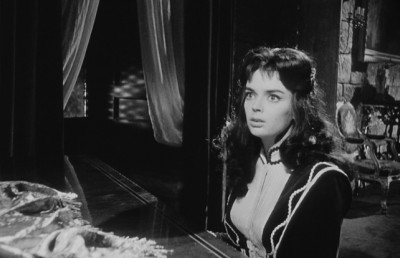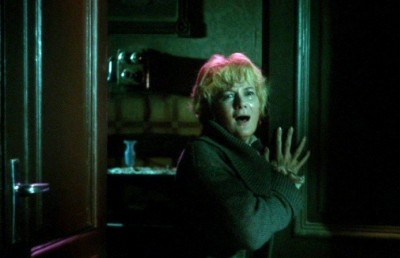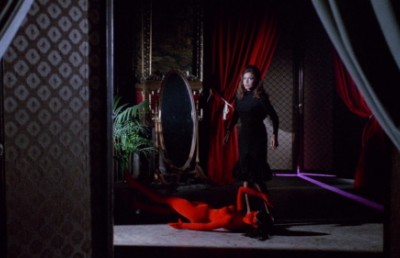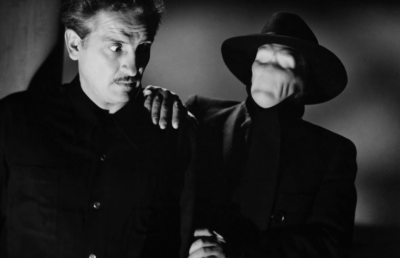Hatchet for the Honeymoon : Optic Zooms and the Haptic Hatchet
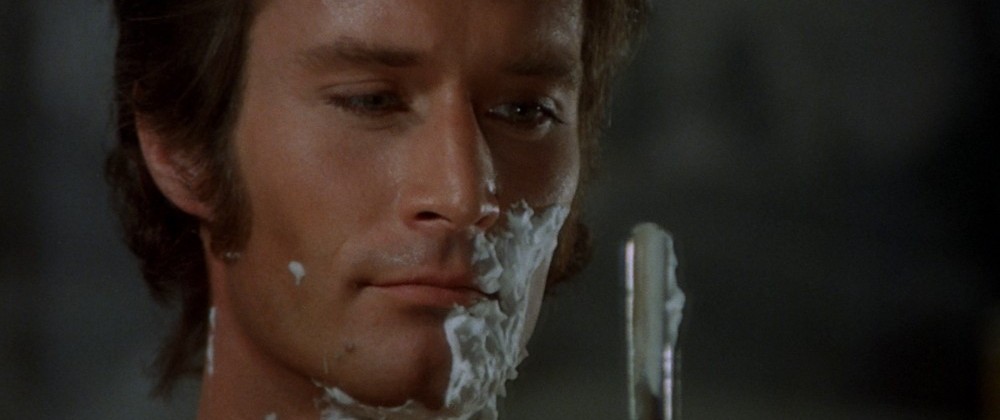
My interest in Mario Bava’s Hatchet for the Honeymoon (1970) began with a fascination for a four-minute segment early in the movie, one which I would repeatedly show in a basic cinema studies class to demonstrate and discuss the use of the zoom. This scene, which is the first of several breakfast encounters between the main character John Harrington (Stephen Forsyth) and his estranged wife, Mildred (Laura Betti), includes nine zooms (seven zoom-ins and two zoom-outs). The movie as a whole contains, at rough count, some 84 zooms (61 zoom-ins and 23 zoom-outs), meaning that, at a running time of just under ninety minutes, we are talking about almost a zoom per minute on average.
Such zoom bulimia might be written off to lazy or cheapskate mise en scène, but this article will argue that Bava’s obsession with zooms-in and zooms-out, whether consciously or not, parallels and complements the themes and motifs of the film. Drawing from the work of theorists Laura U. Marks, and Steven Shaviro, I will argue that Hatchet for the Honeymoon embodies the polarity between what Marks calls “optical vision” and “haptic vision” (162-176). This in turn reflects the narrative’s regular contrasting of hard, cold, inanimate, lifeless appearances with soft, sensual, living, humanly experienced realities.
Let us first, however, summarize the movie’s narrative trajectory, and then discuss how the zoom lens relates to these concepts of the optical and the haptic. Although Mario Bava is associated with the giallo genre, Hatchet for the Honeymoon , whose Italian title Il rosso segno della follia translates as The Red Sign of Madness, is not a typical giallo. There is no mysterious killer. We know from the beginning from the Harrington character’s early voice-over that John has already killed five women, and with the opening scene of the movie we have witnessed his most recent murder. Thus the mystery in the film is not who has been killing brides, sometimes on their wedding nights, but why Harrington has been doing so. He himself does not know, so we are made to identify with the killer, who is seeking to discover what compels him to murder in the bloody style of using a hatchet to chop into the bride, and sometimes the groom, too. Even parts of the advertising campaign played up this novel aspect of the film’s taking the killer’s point of view, in using the words:
When you chop
Aim well! Don’t slip!
And just make sure
She doesn’t drip! (Bava, Blu Ray cover)
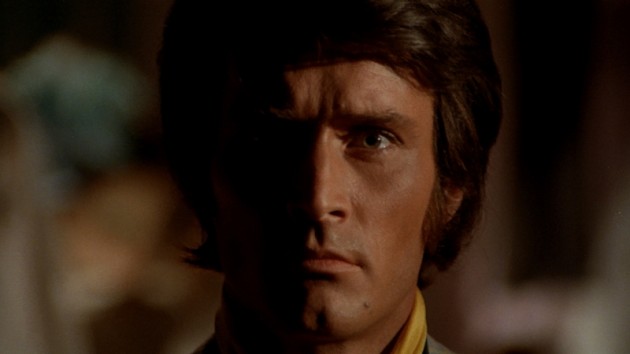
Tim Lucas (not to mention multiple other commentators) has noted that its closest more contemporary counterpart is Mary Harron’s American Psycho (1990), drawn from the Brad Easton Ellis novel, which also asks the audience to take the point of view of a psychotic killer (Tim Lucas, quoted in Cremonini). Troy Howarth has also noted similarities to the Luis Buñuel film The Criminal Life of Archibaldo de la Cruz (1955), which Howarth indicates is one of Bava’s favorite motion pictures (105). The movie is further linked to Spanish culture by having been a Spanish-Italian coproduction. Its Spanish screenwriter, Santiago Moncada, after a successful career as a novelist and playwright, earned some sixty screenwriting credits in film and television between 1966 and 1996 (“Santiago Moncada”). Oddly, the film was shot on the estate of Spanish dictator Generalissimo Francisco Franco, causing Howarth to suggest that “it can be argued that this enables the film to function as a thinly veiled allegory on how the privileged elite bleed the public dry” ( 105 ).
The movie’s main character, John Harrington, has inherited his mother’s bridal couture business, which his wife Mildred has rescued with her personal wealth from economic failure and debt. A bevy of glamorous young women work as models for the house, and Harrington’s most recent victim is one of them who left her job to get married. He replaces her with Helen Scott (Dagmar Lassander), a lithe redhead who walks into his office asking for a job. As the movie progresses, we see him murder Alice (Femi Benussi), a model who is about to leave her employment to get married. We also see Helen aggressively pursue him, apparently seeking a romantic relationship. He ambivalently accepts some of her advances. We, the audience, fear for her. Yet we also watch with anxiety Harrington’s periodic encounters with the police investigator (Jesús Puente) who is working on the case of the movie’s opening victim and her husband.
As the narrative develops, we see Harrington murder Mildred with an axe and first bury her body. At this point the movie either takes a turn into supernatural fantasy or merely portrays Harrington hallucinating, but Mildred appears to become visible to other people but not to John. Spooked by this, he digs her up and cremates her remains in the hothouse incinerator, as he has done with Alice Norton. This touch is a clear bow to Charles Chaplin’s Monsier Verdoux (1947) and perhaps also to Claude Chabrol’s Landru (1963), as well as the pottery oven in the aforementioned Buñuel.
Periodically through the movie, there are cuts to the face and body of a young boy and ominous flashbacks to shots of feet walking up the stairs of the mansion. The boy, it will turn out, is Harrington as a child, as he begins to re-live the experience of climbing the stairs and murdering his mother on the night of her remarriage. This does not become fully apparent until just before the movie ends when Helen, who has been working undercover for the police, is being violently threatened by John, at which point they rescue her. As he is carried off in the wagon, Mildred appears to him (this time invisible to others on screen) and promises with sinister vengeance that they will be together forever. Although Harrington is the villain, he is not completely unsympathetic. As Steven Shaviro writes in The Cinematic Body, “. . . in horror films, we are complicitous with the monster precisely to the extent—and only to the extent—that the latter does not operate from a position of power, but is in its own right victimized and driven by a passive compulsion.” (Italics are Shaviro’s, 61).
But how does this narrative relate to the use of the zoom? In his dazzlingly concise but thorough summary of the various critical stances about the zoom lens, Adam O’Brien discusses the differing attitudes that have been taken toward it. Some commentators have discussed it as a matter of practicality and expense, rendering it a technique to achieve the effect of a dolly-in or dolly-out without the bother and expense of laying tracks. Some treat it as a gimmicky bell or whistle in film production to be used sparingly. Others argue for it having a precise expressive function, as representing a specific mode of learning, subjectivity, or consciousness of the world. O’Brien cites at length the phenomenological approach of Vivian Sobchack, which argues that “the ‘attention’ made visible in the zoom is analogous to learning as an ‘active and constitutive state,’ rather than a benign status quo.” O’Brien then offers his own theory, which argues that the zoom can “serve as a subtle reminder to audiences that a film’s production is a physically located process – and that the fictions we witness are a product of people going somewhere and filming something” (227-231).
I would like to argue that in Hatchet for the Honeymoon , the zoom lens has more of a function of representing a particular attitude toward and envisioning of the world. Of course Mario Bava is known for his ability to work with small budgets and cut production costs, and it is entirely possible that the zooms used were motivated by questions of expense. At the same time, much of Hatchet seems to embody the ideas postulated by Laura U. Marks about “optical vision” and “haptic vision.” As Marks explains:
. . . Optical visuality depends on a separation between the viewing subject and the object. Haptic looking tends to move over the surface of the object rather than plunge into illusionistic depth, not to distinguish form so much as to discern texture. It is more inclined to move than to focus, more inclined to graze than to gaze (162).
A similar point of view is expressed by Steven Shaviro. He first quotes Maurice Blanchot : “Seeing implies distance, the decision that causes separation, the power not to be in contact and to avoid the confusion of contact.” Shaviro explains: “By placing things (and other people) at the proper distance from myself, I am able to constitute them as objects, and have them always ready and at my disposal” (Italics are Shaviro’s, 46-47).
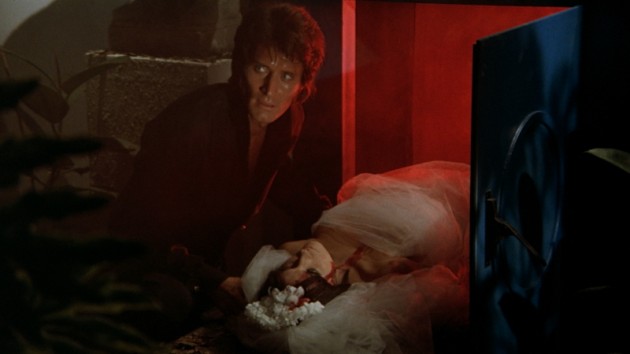
Marks connects optical vision to the idea of a controlling narrative. When visual elements are in perfect optical clarity, the seer is in control and meaning is clear. Haptic cinema, on the other hand, often makes use of soft focus, over- or under-exposure, shaky camera movement, grainy film stock, optical printing, scratching of the emulsion. Such techniques “discourage the viewer from distinguishing objects and encourage a relationship to the screen as a whole” (172). Marks cites a whole movement in contemporary thought of resistance to the ocularcentrism that has traditionally characterized Western culture (133).
One can see therefore that the use of the zoom is very characterized by ocular visuality. Apart from any psychological meaning that a zoom-in or a zoom-out may express, the zoom privileges visuality. Where a dolly-in or a dolly-out or the use of a Steadicam all preserve the kinesthetic experience of moving forward or backward in space, the zoom changes the field of vision mechanically through a change of lens. It deprives us of the tactile-like sensations of changing position in space, which is why some critics see it as an artificial or aesthetically ugly technique.
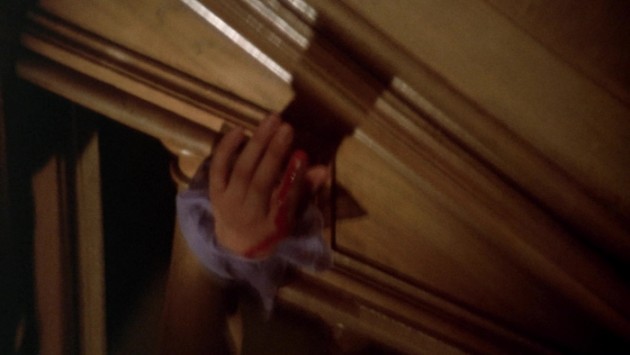
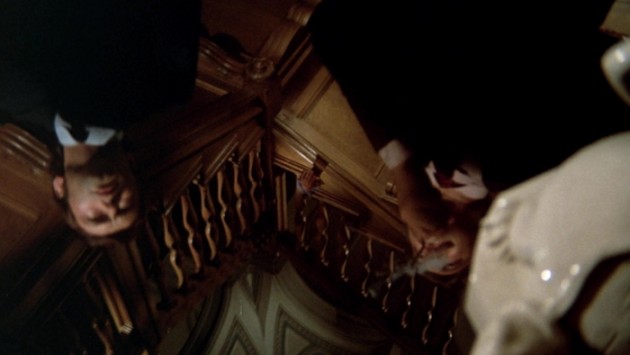
Slow zoom out from a tabletop reflection of dead wife’s bleeding hand
Bava even puts in what may be a self-referential acknowledgement of his preoccupation with the zoom. As Harrington comes down to the breakfast table in the film’s first of several breakfast encounters with Mildred (included in my selected four minutes), he picks up a binoculars and observes models and workers arriving for work. He spies one woman in particular, the model who will become his next victim, seen by the audience in a decisive zoom-in. At the breakfast table, he and his wife have an icy conversation about their marriage, during which John looks at her through the wrong end of the binoculars, presented to us in a point-of-view shot, in a manner similar to the conclusion of an iris-in. This action annoys her and she makes him stop, but his play underlines the distance, both optic and personal, between them. The binoculars otherwise have no diegetic function in the film, but they establish patterns of relationship and control.
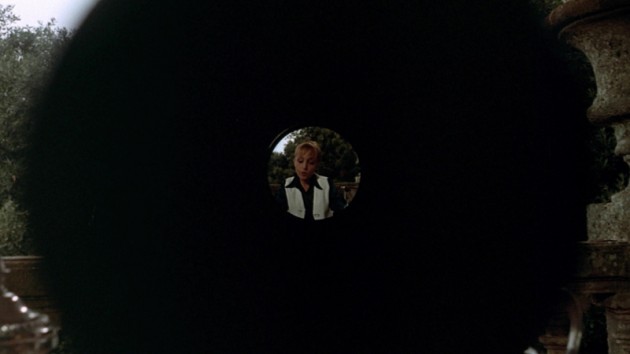
The use of the zoom in Hatchet takes on metaphoric implications. Bava’s movie, like his earlier Blood and Black Lace (1964), takes place in the world of fashion, although the earlier movie, a more conventional giallo, has far fewer zoom shots. But both films are striking in their use of mannequins, creating a formal and thematic opposition between the live models who are threatened with death and the inanimate mannequins that only appear to be life-like. Maxime Duguay has observed how mannequins and dolls are ubiquitous in giallo films. She notes the obvious ironies and contradictions in the comparisons among animate live models who with excessive makeup, perfect hair, and anorexic figures become like inanimate mannequins and often seem headed for the inanimate condition of a corpse (108-113).
One can draw an analogy: The mannequin is to the zoom as the live model is to the dolly shot. The former are optical, cold, artificial, mechanical. The latter are tactile, warm, authentic, imperfect. Some critics have complained about Stephen Forsyth’s performance in the film as being too male-model-like and inexpressive (Dumez; Lenera), but Tim Lucas, who has done what is by far the most extensive analysis of the film, including an audio commentary for the Blu-Ray reissue, has argued that this is exactly appropriate for a character who has become a killing machine and has lost touch with the fragile humanity with which he was born. In the opening scene between John and Mildred, when she asks him to come to the séance with her, he asks her if she is trying to get in touch with her late first husband. Mildred answers John’s nasty response with “At least while he was alive, he was a man. But you, how easily one is deceived by appearances!” The John Harrington character is in some ways a walking mannequin.
Central to the movie’s imagery is Harrington’s private lair, a secret windowless room with a concealed entryway. In it, he has a large, ballroom-sized space with mannequins wearing wedding dresses that his design house has produced. When we first see him enter the room alone, he begins to kiss one of the mannequins with an ardor that seems unnatural and perverse. As the narrative progresses, Moncada and Bava suggest that John’s marriage to Mildred has never been consummated, indicating that this room has become his sexual outlet. As Harrington brings Alice and then Helen to it, intending to dress each of them in a wedding dress, dance gallantly with them, and then murder them, Bava plays with the imagery of the surrounding mannequins who echo their live counterparts. There is a startling shot just before Harrington kills Alice in which she, dressed in the wedding dress, pauses motionless in their conversation for several beats longer than would ordinarily be expected. For just that brief moment, her pose makes her look like a mannequin.
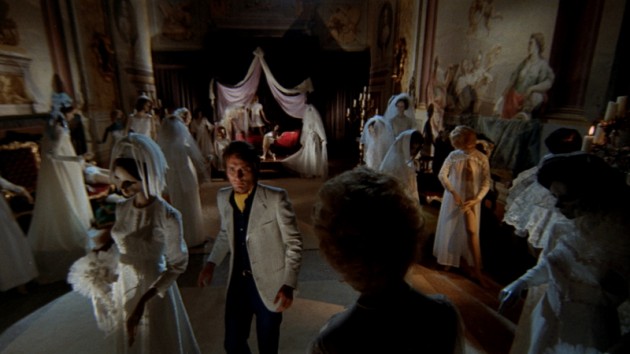
This large secret room has two different analogues in Hatchet. One is the hothouse, where Harrington takes his corpses to be incinerated in the oven there; the other is another room in the house where John has kept his childhood toys. Both can be seen as mannequin-like equivalents of environments from the real world. The hothouse is nature brought indoors, with plants, flowers, and even birds flying about. It is an artificial Eden. We first see the toy room in a playful close-up, immediately following the murder of the bridal couple in the train sleeping car, of a toy train going around tracks, looking at first like nothing so much as an inept miniature shot edited in to the previous take of a real train. These are, in the world of the narrative, simulacra of the real world. They provide toys for the rich.
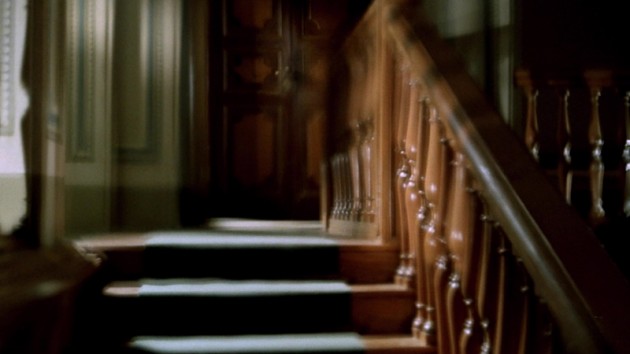
Flashback distortion
Harrington’s cold-blooded calculations suit perfectly the chilly impersonality of the film’s many zoom shots. But the film has a tactile side, one that contrasts this coolness to more haptic imagery. The flashback scenes, which preview the memory of the childhood experience of climbing the mansion stairs before the primal scene that incites the boy’s violence, are frequently shot in a haptic style. Bava, who did his own cinematography on the film, uses what are either distorting lenses or distorting mirrors to render the scene almost illegible. It is an approach that causes Lucas to observe, in his Blu-Ray commentary, that these shots in Hatchet start to look like something from an experimental art film. Similarly, the scenes of Harrington dancing in the mannequin room with Alice and later Helen involve rapid panning that starts to blur the images, concentrating not on the people and objects in front of the camera, but rather the kinesthetic experience of movement. And the four scenes of murder (or attempted murder) use rapid editing, convulsive camera movement, and suggestive sound to create more of an experiential, multisensory approach to violence, rather than a purely visual one. A link to a GIF example, from the murder of Alice, can be found in the Works Cited below (Shudder). Note how the editing creates a participatory sense of layered depth, rather than just a succession of images. Thus Hatchet associates the use of the zoom with scenes of planning, deliberation, and post-murder follow-through, and haptic imagery with scenes immediately preceding and including physical violence. The two approaches embody the mind-body conflict within Harrington. This opposition, one might note, characterizes the central thesis of theorist Jacques Aumont’s L’oeil, la main, et l’esprit, by which, in the words of Marion Poirson-Dechonne, philosophers “oppose la main, emblème de l’action, à l’œil, emblème de l’intelligence” [oppose the hand, symbol of action, to the eye, symbol of intelligence] (19).
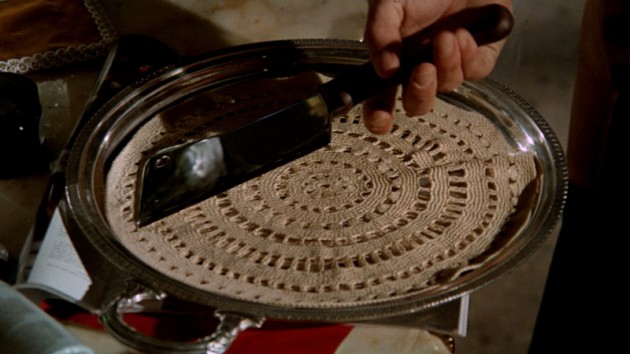
Hatchet for the Honeymoon thus contrasts the implied haptic, loving, touch-filled experience of a newly married couple on their wedding night with the cold metal of the hatchet, haptic in its own way. Lucas has observed that the shot of Harrington wiping the hatchet on the newly-murdered bride’s wedding gown can also be suggestive of the blood coming from the loss of virginity (Audio commentary). The hatchet thus, in its way, becomes a phallic object, a substitute for Harrington’s apparently non-functional penis.
In an odd variant in the classic oedipal model, the boy Harrington murders both his mother and his stepfather. And that murder is preceded by a shot of the boy John looking through the keyhole of his mother and stepfather’s bedroom, a shot that Lucas sees as a homage to a similar shot and narrative configuration in Alfred Hitchcock’s Psycho (1960) (audio commentary). Laura U. Marks is careful not to pigeonhole haptic imagery as solely the domain of the feminine, as one might be expected to do, but nonetheless one can associate the haptic with motherhood, because it is in the mother’s womb that the child first experiences the pleasures of touch (188).
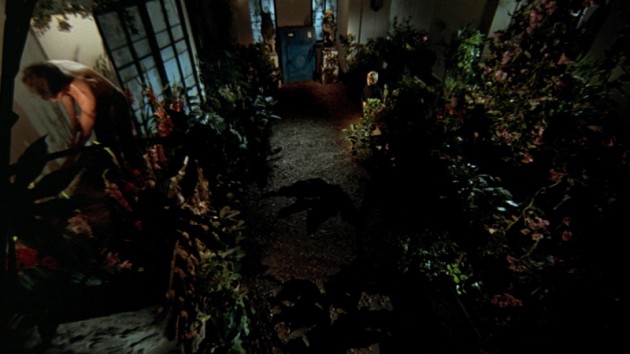
Hothouse
At the same time, in the scene in which Harrington kills his wife Mildred, he dons a bridal veil, which of course becomes bloodied in the process. Might this reversal suggest a desire to replace not the father, but the mother in the oedipal triangle? Does Harrington kill the brides because he hates them or because he envies them? At least by today’s standards, Stephen Forsyth’s costumes lean in a gender-fluid direction, although one must grant that having been shot in 1968, the movie appeared at a time in which standards for sartorial gender designation had become loose. The character is, after all, a fashion designer. Still, one is struck by the metal chain-belt that he wears during the first murder and which appears in later scenes. The chain motif recurs with what is either a jump suit or a pair of pajamas, in a bold black-and-white chain-like print, in one of several scenes at the breakfast table on the patio. Later, at the fashion show, the same chain belts at the waist the designer’s soft velour shirt (with glittery sparkles, a large collar, and a front opening unzipped a third of the way down his bare chest), not through the pants’ belt loops, but on top of the shirt, slung across the hips. From what does Harrington need to be unchained?
Mario Bava is known to have remained for years in an unhappy marriage, and some observers have suggested there is an element of autobiography in the character of John Harrington (Lucas, audio commentary). The movie never demonstrates why Mildred refuses to grant John a divorce, so it might be easier to see her, in her nagging and hovering, more as a replacement mother figure than a wife. That is one of several things that Hatchet for the Honeymoon fails to explain, such as why, given that the setting of the movie is supposed to be in or near Paris, all of the characters have Anglo names – John and Mildred Harrington, Helen Scott, Inspector Russell, Alice Norton. Or what response or consequences at the time the boy John had gotten for having murdered his mother and stepfather.
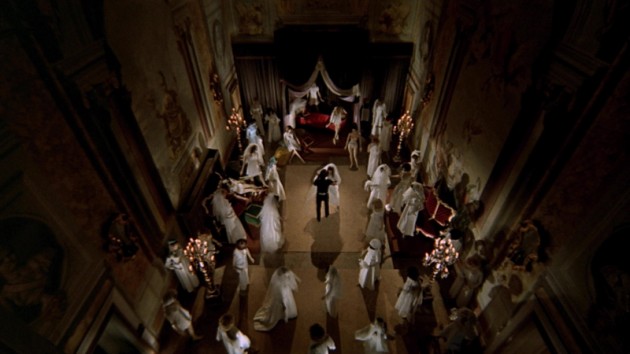
It would be easy, perhaps too easy, to reject Hatchet for the Honeymoon because of these plot peculiarities. It would be easy dismiss its narrative as derivative and contrived, rather than cite its homages to Psycho and Monsieur Verdoux. It would be easy to reject its use of the zoom as excessive and unnecessary. It would be easy to find its performances one-dimensional and lacking in nuance, or to see it as one more misogynistic expression of violence toward women. Thus, the movie has, in the words of Laura Cremonini, “been largely ignored by both critics and audiences, remaining one of Bava’s most obscure films even after his work achieved cult popularity.” Yet the motion picture does have its champions, including Tim Lucas, who sees it as being the start of what he calls the Italian horror film’s “silver age” (“Blood Castle”). Luc Arbona, writing in Les Inrockuptibles, has described it as occupying a space midway between Ed Wood and Luchino Visconti.
Despite its debatable flaws, to dismiss Hatchet for the Honeymoon outright would be to ignore the provocative coherence of what Bava has created. Hatchet for the Honeymoon is important in Bava’s work as much for its novel variations on familiar content as for the style with it presents us its genre-infused narrative. In its multiple simulacra—in characters doubled in mannequins and ghosts, in environments doubled in play rooms, in movement-mimicking zooms—it creates a world not quite like any other in the universe of the giallo, the slasher film, or the Hitchcock-like suspense film.
WORKS CITED
Arbona, Luc. “Une hache pour la lune de miel.” Les Inrockuptibles. 8 November 2006. https://www.lesinrocks.com/cinema/films-a-l-affiche/une-hache-pour-la-lune-de-miel/ Retrieved 2 August 2020.
Bava, Mario. Hatchet for the Honeymoon . Blu-Ray DVD. New York: Kino Lorber, 2012.
Cremonini, Laura. The Ten of Mario Bava. Kindle Edition. 2020. Also in “Hatchet for the Honeymoon .” Wikipedia. https://en.wikipedia.org/wiki/Hatchet_for_the_Honeymoon. Retrieved 20 July, 2020
Duguay, Maxime. “Le style dans le sang: Étude de la scѐne de meurtre du giallo.” Master of Arts Thesis. Université de Montréal. Département d’histoire de l’art et d’études cinématographiques. 2014. https://www.academia.edu/11517847/Le_style_dans_le_sang_%C3%A9tude_de_la_sc%C3%A8ne_de_meurtre_du_giallo?email_work_card=view-paper. Retrieved 19 July 2020.
Dumez, Virgile. “Une hache pour la lune de miel—la critique du film et le test blu-ray (1974)”. Cinedweller. https://cinedweller.com/movie/une-hache-pour-la-lune-de-miel-la-critique-du-film-et-le-test-blu-ray/. Retrieved 1 August 2020
Howarth, Troy. The Haunted World of Mario Bava. Albany, GA: Bear Manor Media, 2018.
Lenera, Dr. “Hatchet for the Honeymoon .´ Horror Cult Films. https://horrorcultfilms.co.uk/2015/06/hatchet-for-the-honeymoon-1969/ Retrieved 1 August 2020.
Lucas, Tim. Audio commentary for Hatchet for the Honeymoon Blu-Ray DVD. New York: Kino Lorber, 2012.
_____. “Blood Castle: Gold from the Silver Age.” Video Watchdog. Blogspot. 9 August 2006. https://videowatchdog.blogspot.com/2006/08/blood-castle-gold-from-silver-age.html. Retrieved 19 July 2020.
Marks, Laura U. The Skin of the Film: Intercultural Cinema, Embodiment, and the Senses. Durham: Duke University Press, 2000.
O’Brien, Adam. “When a film remembers its filming: The New Hollywood zoom.” Journal of Media Practice. 13.3 (2012), 227-237. https://people.southwestern.edu/~bednarb/filmstudies/articles/obrien.pdf. Retrieved 19 July 2020.
Poirson-Dechonne, Marion. “Synesthésies au cinéma ou l’expression d’une poétique.” Ekphrasis. 7.1 (2012), 9-26. https://www.academia.edu/10194167/Synesthesia_in_Cinema_and_Visual_Arts?email_work_card=view-paper Retrieved 26 July 2020.
“Santiago Moncada.” IMDb. https://www.imdb.com/name/nm0597604/?ref_=nv_sr_srsg_0. Retrieved 20 July 2020.
Shaviro, Steven. The Cinematic Body. Theory Out of Bounds, Vol. 2. Minneapolis: University of Minnesota Press, 1993.
Shudder. Mario Bava horror GIF. https://giphy.com/gifs/shudder-horror-wedding-bride-xThuW3lQEdtWHFuPJe. Retrieved 19 July 2020.


